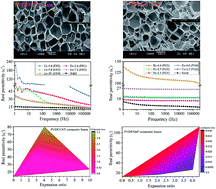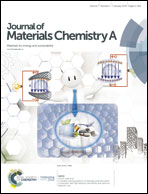A versatile foaming platform to fabricate polymer/carbon composites with high dielectric permittivity and ultra-low dielectric loss†
Abstract
There is an urgent need for dielectric-based capacitors to manage the increase in storage systems related to renewable energy production. Such capacitors must have superior qualities that include light weight, a high dielectric constant, and ultra-low dielectric loss. Poly(vinylidene fluoride) (PVDF)/carbon (carbon nanotube (CNT) or graphene nanoplatelet (GnP)) nanocomposite foams are considered promising alternatives to solid PVDF/carbon nanocomposites. This is because they have excellent dielectric properties, which are due to the preferred orientation of their carbon materials occurring in the foaming process. In the PVDF/carbon foams, their microcellular structure significantly influenced their electrical conductivity and dielectric properties. In the PVDF/CNT composite foams, the electrical conductivity was increased by an increased degree of foaming that was below a critical foaming degree. The CNTs even formed conductive networks and this caused current leakage. Thus, in the PVDF/CNT foam sample with an expansion ratio of 4.0 where a high dielectric constant of 80.6 was obtained, a relatively high dielectric loss of 3.51 was observed at the same time. In the PVDF/GnP composite foams, the presence of a microcellular structure forcefully increased the distance between GnPs. This induced and produced the insulating quality of the PVDF/GnP foams. In addition, the parallel graphene nanoplatelets that accompanied this process were close together, and they isolated the polymer layer, or air, as a medium between themselves. An unprecedentedly high dielectric constant of 112.1 and an ultra-low dielectric loss of 0.032 at 100 Hz were obtained from the PVDF/GnP composite foam with a high expansion ratio of 4.4 due to charge accumulation at the aligned conductive filler/insulating polymer (or air bubble) interface.

- This article is part of the themed collection: 2019 Journal of Materials Chemistry A Most Popular Articles


 Please wait while we load your content...
Please wait while we load your content...